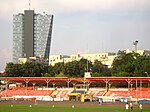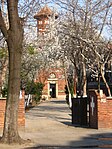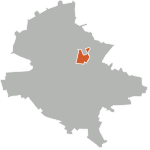Bucharest Metropolitan Circus
Buildings and structures in BucharestCircuses in BucharestCulture in BucharestEvent venues established in 1961Historic monuments in Bucharest ... and 1 more
Tourist attractions in Bucharest

The Bucharest Metropolitan Circus (Romanian: Circul Metropolitan București), also known as Bucharest State Circus, or Globus Circus, is a circus located at 15 Circului Alley in Bucharest, Romania. Built in 1960-1961 by architects Nicolae Porumbescu, Nicolae Pruncu and Constantin Ruleahe, the circus is listed in the National Register of Historic Monuments in Romania. It has a capacity of up to 1,850 seats.
Excerpt from the Wikipedia article Bucharest Metropolitan Circus (License: CC BY-SA 3.0, Authors, Images).Bucharest Metropolitan Circus
Aleea Circului, Bucharest Tei (Sector 2)
Geographical coordinates (GPS) Address External links Nearby Places Show on map
Geographical coordinates (GPS)
| Latitude | Longitude |
|---|---|
| N 44.456314 ° | E 26.109695 ° |
Address
Circul Globus
Aleea Circului 15
021103 Bucharest, Tei (Sector 2)
Romania
Open on Google Maps







